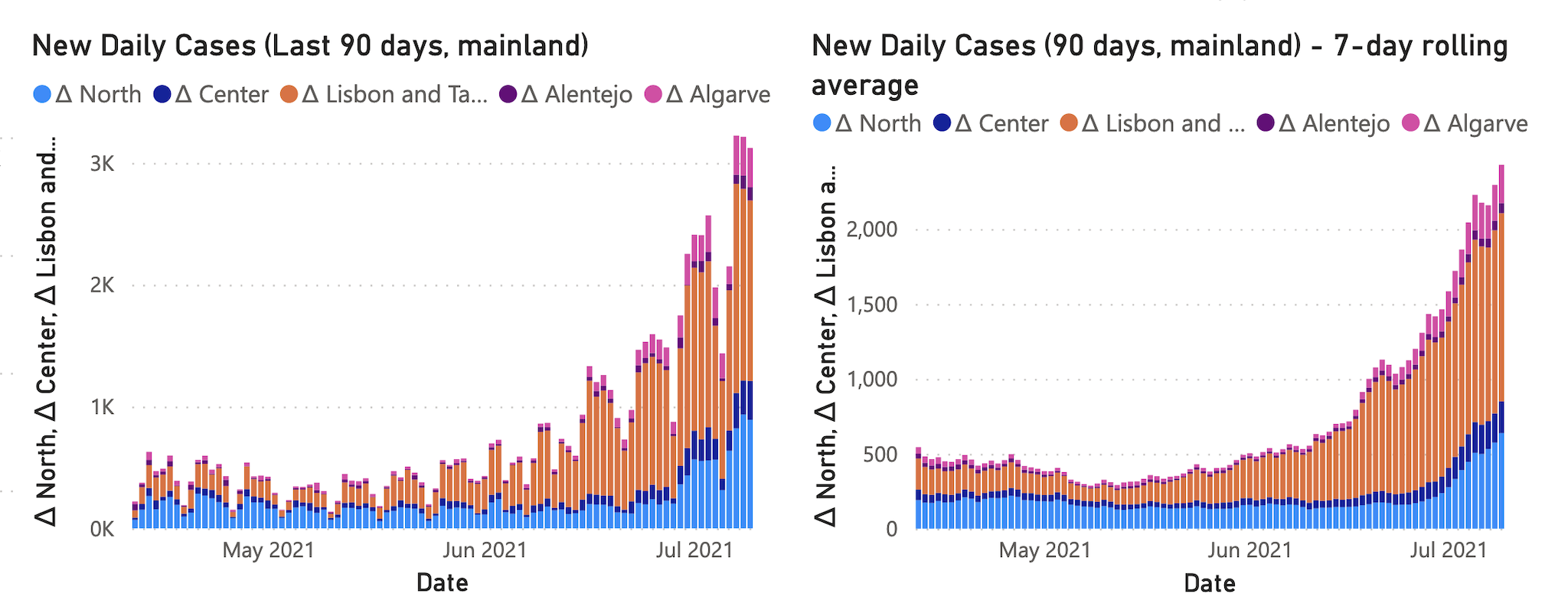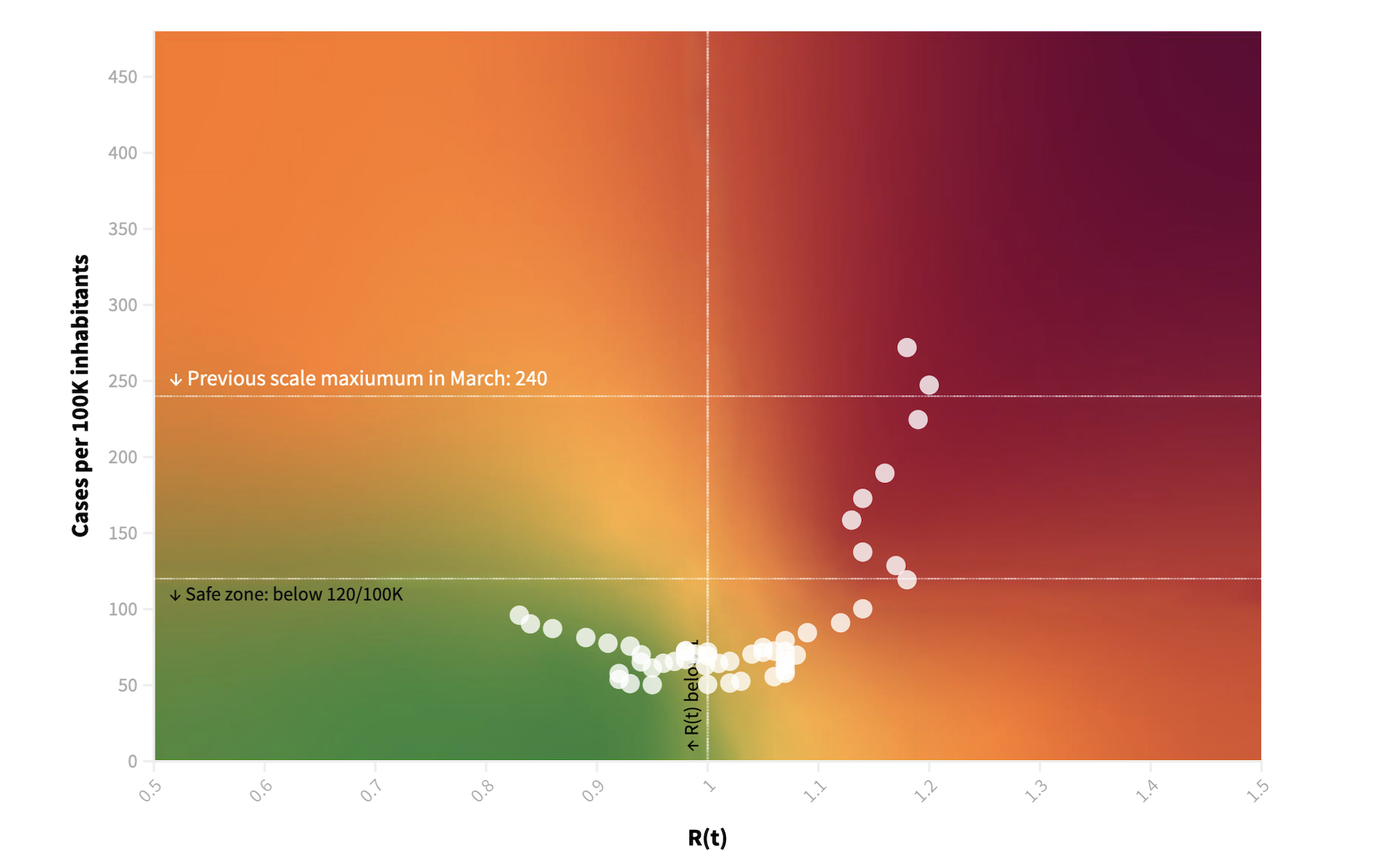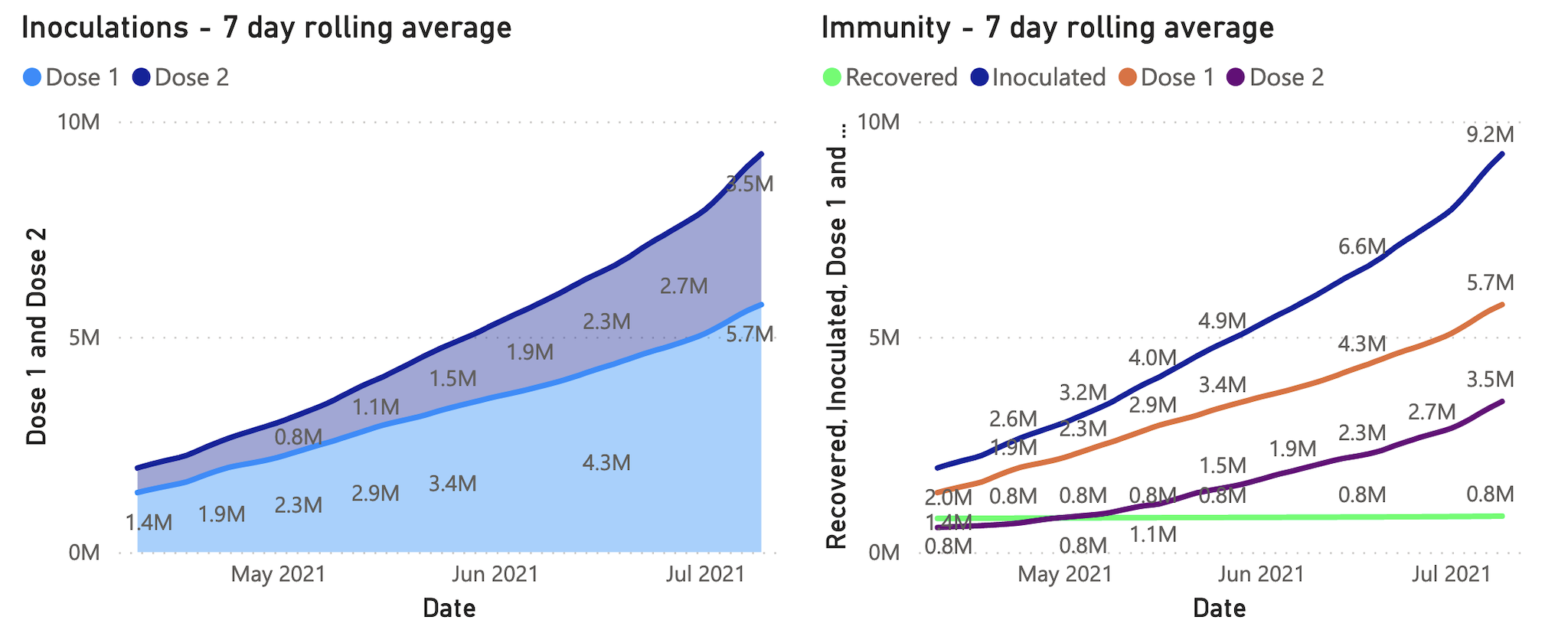It’s been roughly 80 days since my last update on the pandemic saga and my dataset has just crossed 500 rows, so I thought it was time to look at my dashboard, pick out some highlights and recount what has been going on since.
This series began 50 days after the start of the pandemic and has had irregular updates 120, 200-ish, 250-ish, 300-ish, 320-ish, 333, one year and 420 days later.
Current Status
Back in June 18th Lisbon had a spurt of new cases (mostly driven by the Delta variant) that prompted the government to (laughingly) restrict travel on weekends (with the obvious result that punters just left town by close of business on Friday), and which is now pretty much on an exponential growth trajectory:

Let’s zoom in on that far right and look at what it’s been like for the last 90 days in the mainland:

As before, I blame this squarely on government mishandling of the situation–although confinement was enforced on a more granular basis than before, they repeatedly moved the goalposts in some critical regions, and continued to relax restrictions as vaccination was ratcheted up (more on that later).
Still Missing The Point
Just like before, the demographic data shows that cases continued to rise in the 10-29 age range, something that was compounded by warmer weather and the relaxation that came with the end of school across younger segments, which remain unvaccinated.

The “good” news is that deaths have significantly decreased (under 10 a day):

But that is a pretty misleading indicator, as there is renewed stress on the health system and a clearly upwards trend in hospital stays, even if less (immediately) serious:

Since deaths are low, people assume there is less danger (a massively dangerous side effect of the false sense of security brought by vaccination) and a fair amount of the population seems blissfully happy with things.
TV news has covered various night time escapades and police actions concerning younger folk, but another disturbing show of carelessness is that even though we haven’t had a spat of major public events of late, there are reports of companies pressuring people to return to the office and (unbelievably) asking people to remove their masks in meetings.
Consecutive Government Blunders
In a show of institutional incompetence that is reminiscent of the UK, the “risk matrix” that the Portuguese Government defined (which was borderline inscrutable when first presented and still a textbook case on how to mis-represent data) has “evolved” over time, in tandem with the urge to remove restrictions at all costs while avoiding political accountability.
Initially defined in March as a 4-zone diagram with “hard lines” that would mandate enforcement of restrictions in case incidence (cases per 100K inhabitants) or Rt crossed pre-defined values, it was finally revised this week (July 7

Of course nothing substantial happened when any of the critical lines was crossed.
And as new variants were identified and contributed to the increasing number of cases the government has actively begun pushing back on enforcing stricter measures and keeps emphasizing vaccination (good) while trying to “support businesses” by doing things like the ridiculous “weekend curfew” I wrote about earlier and mandating that restaurants check vaccination certificates (which is just laughably useless).
Since there is no political will to go back to a state of emergency, things were simply allowed to stew until it was too obvious to ignore–and, even then, the misconception that lower deaths is an improvement when long-term effects are still under debate is just too dangerous not to note.
Unevenly Timed Vaccination
I’ve already had one shot (of Moderna, if you must know), and will be getting the second next week. But looking at the bigger picture, we’re at about 40% where it regards full vaccination–there were almost 10M jabs already, which break down into various degrees of possible “immunity” (into which I’m also factoring known recovered cases as a baseline):

The notable thing here is that it took us forever to get to the 20-29 demographic, which has been the most problematic and is only now allowed to book some appointments (vaccination for 25 year olds opened this week).
To make a long story short, the government is essentially trying to accelerate vaccination to compensate for their earlier blunders. And, in a typical symptom of rushed decision-making, we’re doing so at the expense of overbooking vaccination centres.
But the weird strategy of keeping sub-65s on hold until June and then (in the space of a few weeks) opening up vaccination to younger people in a huff (but only until 35 for a long time) essentially meant that while we were indeed protecting older people, 20-29s (and younger) were running around partying and frolicking, a situation that was exacerbated by the end of the second term late June.
And I strongly suspect the overbooking strategy is going to backfire. Last week there were 4 to 6 hour waiting times in some locations (not a good thing when heat is creeping past 32oC), something that the Prime Minister dismissed as a minor inconvenience.
Then again, at least he’s not raring to go to a pub.